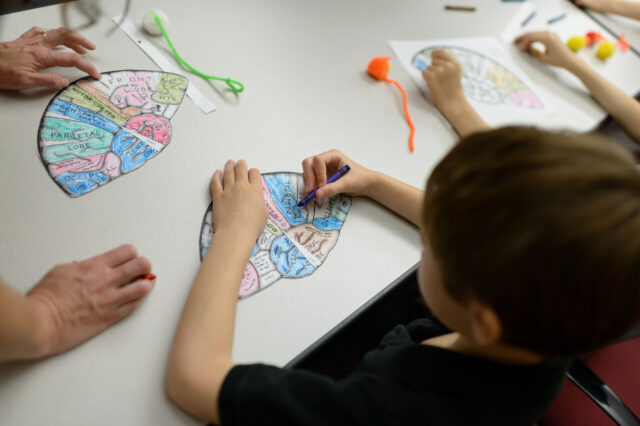Students take part in Brain Awareness Week activities at McKnight Brain Institute

Paran Davari asked the group of elementary school students to name one of the five senses.
An answer came fast from the talkative 6-year-old girl in the front row.
“Taste! Like when I eat ice cream!,” said Amber Andrews, a homeschooled kindergartner.
Amber was among 51 students who visited the Evelyn F. and William L. McKnight Brain Institute of the University of Florida on Wednesday for a Brain Awareness Week event. The global Brain Awareness Week campaign aims to increase public awareness of the progress and benefits of brain research.
Davari, an undergraduate biology major at UF, taught the 26 younger children about blind spots and how they can lead to car crashes. She showed them how the inner ear detects different sound frequencies and works with the brain to process those signals. She explained how taste buds connect to the brain, allowing someone to savor a handful of jellybeans.
Later, the children built neuron models out of colored pipe cleaners and learned about the lobes of the brain by coloring and building paper “brain hats.”
The whole time, Amber peppered Davari with questions and soaked in the answers.
“I learned about my blind spot. I’m a lot smarter now,” she said.
Next door, 25 older grade-school students inspected a sheep brain resting on a paper plate.
“Find the hippocampus,” neuroscience graduate student Brittany Butler said to the group. Rhianna Brown was among the first students to make the discovery, triumphantly raising the specimen to eye level.
“This is it,” Brown said as two other students looked on.
That was Butler’s cue to start explaining the role of the hippocampus, a tiny region of the brain that helps govern memories. The hippocampus was just one stop on Butler’s guided tour of brain anatomy for the students,
Each part of the brain came with a lesson about its crucial functions. The temporal lobe allows a person to form coherent sentences. The primary motor cortex controls movement. The prefrontal cortex sits just behind the forehead and helps regulate behavior.
“When you lose your prefrontal cortex, you won’t be yourself anymore,” Butler said. “So wear your seat belt.”
But it wasn’t all about weighty science: Butler drew some laughs from the students by pointing out the part of the brain that makes girls mature more quickly than boys. Brown, a homeschooled seventh-grader, couldn’t resist pointing a finger and giving a knowing glance at a 13-year-old boy nearby.
About the author
